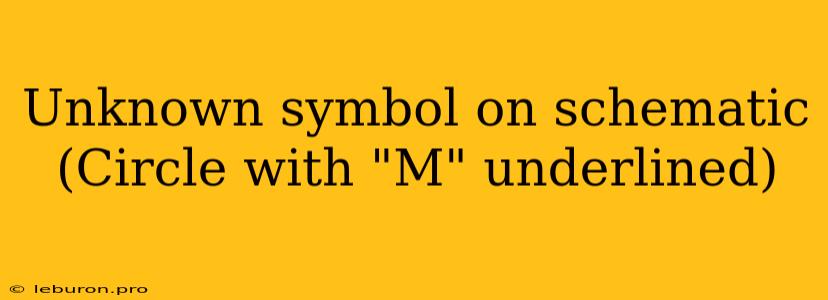Encountering an unfamiliar symbol on a schematic diagram can be frustrating, especially when it's crucial for understanding the circuit's functionality. One such symbol, often depicted as a circle with an underlined "M," can leave engineers and hobbyists alike scratching their heads. This symbol, while seemingly obscure, represents a critical component known as a mutual inductor. In this article, we'll delve into the meaning of this symbol, explore its significance in circuit design, and discuss how it operates within a circuit.
Understanding the "M" Symbol: A Gateway to Mutual Inductance
The symbol, a circle enclosing an underlined "M," represents a mutual inductor, a component crucial in circuits involving transformer action. Mutual inductors are essential for applications like power supplies, transformers, and energy transfer systems.
The Essence of Mutual Inductance
Mutual inductance occurs when two coils are placed near each other, allowing magnetic flux from one coil to link with the other. This magnetic coupling results in a mutual inductance value represented by the letter "M."
Key Points:
- Magnetic Flux Linkage: The degree of magnetic coupling between the two coils directly influences the mutual inductance.
- Inductance and Coupling: The symbol "M" represents the mutual inductance, and the closer the coils are, the greater the mutual inductance, increasing the potential for energy transfer.
- Transformers: Mutual inductors form the core of transformers, where one coil (the primary winding) receives energy, and another coil (the secondary winding) receives energy inductively through the mutual inductance.
Applications of Mutual Inductors
Mutual inductors find widespread application in a variety of electrical and electronic systems:
Power Supplies
Mutual inductors are employed in power supplies to transfer power from the primary winding to the secondary winding, providing a safe and efficient method of voltage transformation.
Transformers
Transformers rely heavily on mutual inductance for voltage and current conversion. The primary winding receives power, and the mutual inductance transfers energy to the secondary winding, which can then provide a different voltage and current output.
Energy Transfer Systems
Mutual inductors play a key role in wireless energy transfer systems. These systems utilize magnetic coupling to transfer energy without any physical connection, paving the way for innovative technologies like wireless charging.
How Mutual Inductors Function
The operation of a mutual inductor hinges on the principle of electromagnetic induction. When current flows through one coil (the primary coil), it generates a magnetic field. This magnetic field then interacts with the second coil (the secondary coil), inducing a voltage across it.
Faraday's Law
Faraday's law of electromagnetic induction governs this process, stating that the induced voltage in a coil is proportional to the rate of change of magnetic flux through the coil. The mutual inductance value determines the efficiency of energy transfer between the coils.
Coupling Coefficient
The coupling coefficient (k), a crucial parameter in mutual inductance, indicates how effectively the magnetic flux from one coil links with the other. A coupling coefficient of 1 represents perfect magnetic coupling, while a value of 0 indicates no coupling.
Exploring the Symbol's Context
When encountering the "M" symbol on a schematic, it's essential to consider the surrounding components and context to understand its role in the circuit.
Identifying Key Features
- Coil Symbol: The "M" symbol often accompanies two coils, indicating their mutual inductance.
- Direction of Current Flow: The direction of current flow through the coils can be indicated by arrows, highlighting the interaction of magnetic fields.
- Values: The mutual inductance value "M" is often provided alongside the symbol, indicating the strength of the magnetic coupling.
Considerations
- Circuit Topology: The arrangement of the coils within the circuit determines the type of transformer action and the intended function of the mutual inductance.
- Component Values: The values of other components, such as resistors and capacitors, influence the overall performance of the mutual inductor circuit.
- Frequency: The frequency of the current passing through the coils can affect the mutual inductance, as it impacts the magnetic field strength.
Conclusion: Decoding the "M" Symbol
The circle with an underlined "M" on a schematic represents a mutual inductor, a component essential in circuit design and power transfer applications. By understanding its significance and how it operates, engineers and hobbyists can effectively utilize mutual inductors in their projects. This symbol, often a source of confusion, becomes a gateway to understanding the principles of magnetic coupling and its vital role in various electrical and electronic systems. As technology advances, the importance of mutual inductance and its related symbol will continue to grow, driving innovation in areas like wireless power transfer, energy storage, and more.
